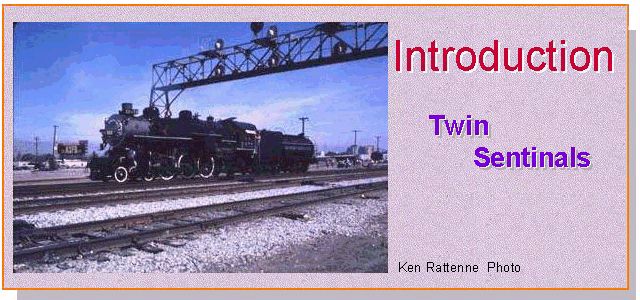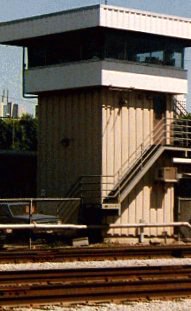
San Jose Sentinels I
By Ken Rattenne

 |
| Former Southern Pacific 4-6-2 No. 2472 drifts light through College Park's trackwork during one of the engine's first outings in September of 1991. The College Park Tower operator has the plant aligned to allow the handsome Pacific to cross over to the College Park Yard lead and couple to it's waiting excursion train. (Ken Rattenne Photo) |
INTRODUCTION: TWIN SENTINALS
It's nearly dusk on a late fall afternoon in 1992 as Gary Lower stands erect from the ancient desk where he has been doing paperwork. "Let me roll this guy by" he says, almost apologetically. Looking south from College Park Tower's lofty vantage point, Gary's two visitors spy a northbound "plug" rounding the curve adjacent to the now-abandoned former Southern Pacific engine facility. The five car weekend CalTrain looks unusually graceful as the fading light reflects off the fluted sides of the cab car and its trailing coaches. Gary leans out the tower window closest to the track and waves the engineer by with a highball. "917 at 5:04 PM" he states as he logs the trains passage in the tower's Train Movement sheet. "Gary's the last operator to give roll-bys at College Park" says Amtrak engineer Phil Gosney. Phil should know - he pilots Amtrak's early morning Capitol train from San Jose to Sacramento each weekday, and Phil says he doesn't get the traditional roll-by from the morning operator when his short charge passes by.
Leaving the tower behind in a trail of exhaust and dust, engine 917 blows for Stockton Avenue then enters the south (railroad east) end of San Jose Yard for the short sprint to Santa Clara, 1.4 miles to the north. At Santa Clara Tower, the operator barely looks up as the commute train accelerates away from its stop at the 100-plus year-old depot. San Francisco-bound trains seldom need attention, requiring no more than the visual roll-by and entry into the Record of Train Movements sheet. Today's train shoots straight through the tower's interlocking plant (as it usually does) and once past, the quiet of a fall evening once again overtakes the structure.
Tower Consolidation Project
In their final days, Santa Clara and College Park towers operated in the same fashion as when first built in the mid-1920s. By the end of 1992 the pair of towers had witnessed a multitude of changes: Dramatically reduced freight movements, rampant closing of area yards, radio-issued train orders (called Direct Train Control), and the takeover of operations by Amtrak. Nonetheless, operators in each structure continued to perform the time-honored duties associated with towers everywhere: Aligning switches, setting signals and keeping the busy flow of freight and passenger traffic fluid through their domain. But it was not to last.
It was called the Tower Consolidation Project
and had been in the planning stages years. The project's goal was to combine
the functions of all four of the Peninsula's interlocking towers into a
single centralized dispatching center housed in San Francisco. When finally
started, officials had changed the dispatching center's location to San
Jose and released a schedule listing the order each tower would be closed.
There was no doubt it was the beginning of the end for the Peninsula's
towers.
| On July 1, 1992, Amtrak began operating CalTrain
service for new owners JPB (Joint Powers Board) on what is now known as
the Peninsula Corridor. On that same day the JPB took title to all CalTrain
assets and property, including the two towers and San Jose Telegraph. The
SP-employed tower operators were given a leave of absence from the "Friendly"
in order to finish working out their positions until the planned closure
of tower. Their paychecks were now signed by Amtrak.
The first victim of the consolidation was
San Jose Telegraph, a control center hidden in
the inner reaches of the Cahill Street passenger depot. Next was San Francisco's
Fourth Street Tower, then in 1993 College Park and
Santa Clara Towers were closed for good. Another
chapter in Bay Area railroading had just ended.
|

Fourth Street Tower in San Francisco was the second tower to be closed by the Tower Consolidation Project. It was built in 1975 in conjunction with the constructon of SP's new Fourth Street station. (Ken Rattenne photo) |
This document is Copyright
©1998-2002 by Ken Rattenne and KPR Media Services
and was last updated in March of 2002.